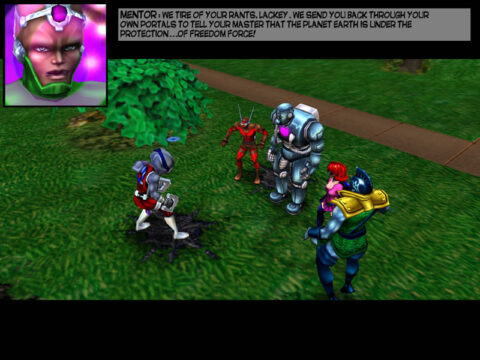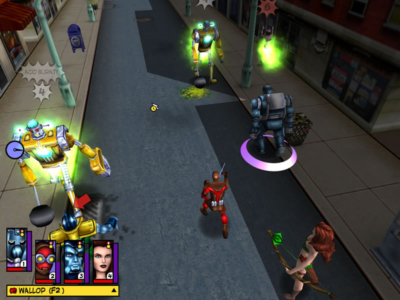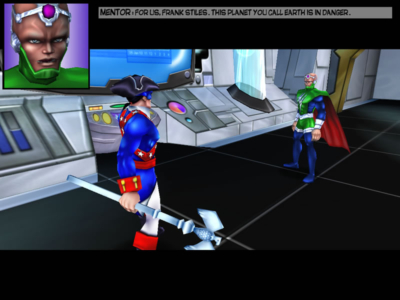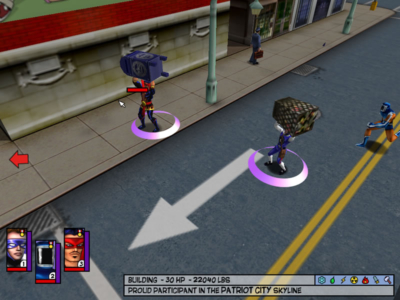
Freedom Force
Written by: Stoo
Date posted: March 11, 2006
- Genre: Strategy
- Developed by: Irrational Games
- Published by: Crave Entertainment
- Year released: 2002
- Our score: 8
There were two initial points of attraction for me in picking up Freedom Force. Firstly, it’s a game of comic-book style superheroes. I’m not a really hardcore comics fan, but I do follow Spiderman on a semi-regular basis, and so see plenty of potential in implausible spandex-clad heroics. Secondly (and more importantly), it was developed by Irrational Games, who were also behind the rather fantastic System Shock 2. That was an entirely different kind of game, of course, but proved the great talent of this team. Oh, there’s a third point too: it’s sat on the ?5 shelves of every gaming shop in the country, which I naturally gravitate towards thanks to my cheapskate nature.
Freedom Force is a kind of tactical-battle-RPG that’s a little tricky to file into our regular definitions. Set across twenty-five ish missions, in each you control a team of up to four super heroes. In realtime and fairly spiffy 3D, you must direct them to beat up crooks, aliens and monsters, protect innocent civilians, and sometimes tackle a powerful supervillain. Which does sound quite a fantastic prospect. After each mission your heroes are awarded experience points; accumulate enough of these and you can upgrade their abilities and superpowers.
The setting is based heavily on the ‘silver age’ of comics, which ran from the 1950s to 1970s. (if you’re wondering, the Golden Age was apparently back in the 30s, through to the end of the second world war). It;s all about bright colours, and relatively simple themes. The good guys are valiant heroes, the bad guys gloat over their Evil Plans to Destroy the City. Not a lot of room for grey areas here. The voice acting is suitably hammy and over-the top, and characters…often…talk…with..pauses! No-one is ever killed (just ko’d), it’s perfectly acceptable to say ‘jeepers!’ if you’re a young and enthusiastic sidekick, and flags are waved in a patriotic manner.
That’s not to say it’s always completely frivolous though. There is a little interpersonal drama along the way, through dialogue between team members and a modicum of character development. One of the team is a poignant figure haunted by a past where his powers killed someone he loved. Another openly questions the ethics of having super-powered kids as sidekicks on the team. The occasional thoughtful moment aside, tho, it’s mostly about POW!, BIFF! and bringing nefarious villains to justice.
There is of course a wide range of opportunity for satire here that Irrational chose to completely ignore – but then maybe it’s too easy to be cynical these days. They’ve opted to revel in an unashamedly clear-cut, old-fashioned style of heroics and why not, it’s all good fun. I’d love to see a sequel in a darker, more modern style also but there’s plenty of room for both. For today, we’re here for superpowered action and simple good vs evil.
As for the heroes themselves, they’re a likeable bunch. Each gets a brief introduction story, done comic-style of course with suitable artwork for the era. Leader Minuteman is a patriotic type in the Captain America style, crying FOR FREEDOM as he wallops baddies. El Diablo is a latino hothead with fire powers, and the Ant is a teenage science geek blessed with super-strength and wall-crawling (sound familiar?). Man-O-War meanwhile is not based on the American cod-metal band, but rather a Scottish seafaring type boasting powers of water, lightning and bad Sean Connery impressions. Team founder Mentor, carries with him knowledge of the Energy X that gave everyone their powers in the first place, and of the terrible evils lurking in space that may prove the downfall of mankind. He also has just about the hammiest, most overly dramatic voice of the lot. There are ladies too – Alchemiss with her sourcerous powers, and nature-loving Eve.
Battle is pretty easy to pick up, all straightforward point-and-click stuff. Characters have a range of attacks and special powers they can use, with varying energy cost depending on the strength of the move. For example El Diablo can execute a quick right hook as his basic attack, but also has access to a more powerful flaming-fist punch, or flinging a blast of heat. Other heroes can shoot radiation beams, or scramble enemy minds, or just administer particularly devastating physical blows. Damage falls into certain classes (hot, cold, radiation etc) and everyone has varying resistance or vulnerability to these. Apart from direct damage-dealing, you also have options that might paralyse enemies, or shield your heroes from harm. For mobility a few heroes can fly, others lack that ability but can effortlessly leap atop buildings. The more tank-like ones must plod around on foot.
An appealing feature of combat is your ability to use bits of the scenery as weapons. Trash cans and crates can be picked up and thrown at enemies; your stronger heroes can even hurl cars around. Also lamp-posts and pillars can be wrenched out of the ground and used as huge clubs; there’s something immensely satisfying about watching three crooks go flying at once. Buildings can also be destroyed although this is generally something to be avoided. You’re supposed to be protectors of the city, after all. It looks a bit bad for public relations if you flatten three blocks trying to catch a bank robber.
The RPG side to all this is straightforward enough too; heroes get a certain number of experience points every time they take part in a mission. Those left to wait it out back at home gain points at a slower rate. Every time a hero gains enough points, they may ‘purchase’ new powers or upgrade existing powers. Completing mission objectives also gains the team prestige points; these may be used to add new heroes to the team. More such points are often available for completing secondary objectives, like minimising damage to buildings or foiling a robbery along the way.
One further feature is the hero generator. You can use this to dream up your own heroes, giving them attributes and powers. There’s a basic set of character models and skins on offer (ie physical appearances), but thousands more created by fans on the internet. In-game these heroes can be purchased with prestige, same as existing ones.
Your first serious foes are mostly communists – the latter being perfect for the 1960s setting. With a perfectly straight face the game delivers troops armed with freeze rays and dodgy accents and their ruthless leader, the Energy-X powered Nuclear Winter. Later on you’ll be up against giant robots (yay!), subterranean troglodytes, and alien invaders. There are often crooks, gangsters and bank robbers around also, the bread-and-butter of Superhero work.
That’s an outline of how it all works. I did find though, that for all the spandex and superpowers on display, I was taking a surprisingly cautious approach. You might think your heroes could just leap right into battle, fists swinging and bolts of energy flying. At least against common foes (as opposed to super-powred bosses) you might expect to swoop in, swiftly knock heads together and leap off on your heroic way again. Well, it’s not quite that easy and even regular enemies can do a fair bit of damage if you just charge in headlong.
Of course, It would quickly get dull if you could rout the enemy with ease every single time. I was just a little disheartened by how on some maps, I found myself ordering the team to fling postboxes and bins from maximum range and then run for cover. Or trying to fight just one enemy at a time, either by crawling across the map very carefully, or luring them away from their comrades. That style would fit a game about SAS soldiers perfectly well, but it doesn’t seem very heroic to me.
Success comes through, if you learn to appreciate the heroes’ strengths and weaknesses. Also, you have to get used tohitting pause a lot to reconsider the situation and hand out new orders. With patience, practise and careful deployment it becomes more fun than just bin-flinging. WOOSH! Manowar slams baddies into a wall with a jet of water. BOOM! El-Dialbo’s fireball sends them flying this way and that. POW! As they’re struggling back to their feet, the Ant and Minuteman finish them off with some good old hand-to-hand pummelling.
The structure of missions is fairly linear – for the most part triggering one fight after another, usually before a final more demanding fight to round off the map. What I’d like to see is a full, living and breathing city (think GTA) that exists outside specific missions, with unscripted action generated along the way as long a scripted objectives. That’s an objective for next time, perhaps. Don’t worry about missions getting too repetitive though, if nothing else the nature of your enemies changes a fair bit, as do the surroundings. Also occasionally you’ll be thrown something a little different, such as trying to protect buildings from robot attack. This forces you to use your wits, quickly and aggressively, rather than just tackling them in your own time.
Just a couple more annoyances:; I was never entirely convinced heroes were responding to my commands in battle without repeated clicks. They could also do with a little more intelligence to handle foes themselves without your constant guidance, especially in situations where you’re forced to split the time. On another note, I’ve read that heroes and their powers aren’t balanced as well as they could be; as in, some are repeatedly found to be far more effective and game-winning than others. I’ve not fully investigated this side of things myself, however – I’ll revise this review if I ever get to grips with the hero-generating process myself.
Freedom force is the kind of game that should have quite a wide appeal. It’s easy to pick up, genre-spanning, and a lot of fun. You just have to remember that heroes are not unstoppable or indestructible, and must be carefully guided. There’s enough numbers and stats around to keep geeks happy, but much of this is placed behind menu options that more casual fans can happily ignore. Some people might have trouble with the campy setting; you just have to approach the game in the spirit in which it’s intended. You’ll grin as baddies are sent flying skywards, roll-your eyes at Minuteman’s cheesy lines, and frown at the latest supervillain boss-fight as you hit pause and plot a series of moves to deal him some damage. Those of you yearning for something dark and brooding like a modern comic, or a complex storyline with genuinely gripping drama, will have to wait a while. Otherwise, it’s all great fun.





 Posts
Posts